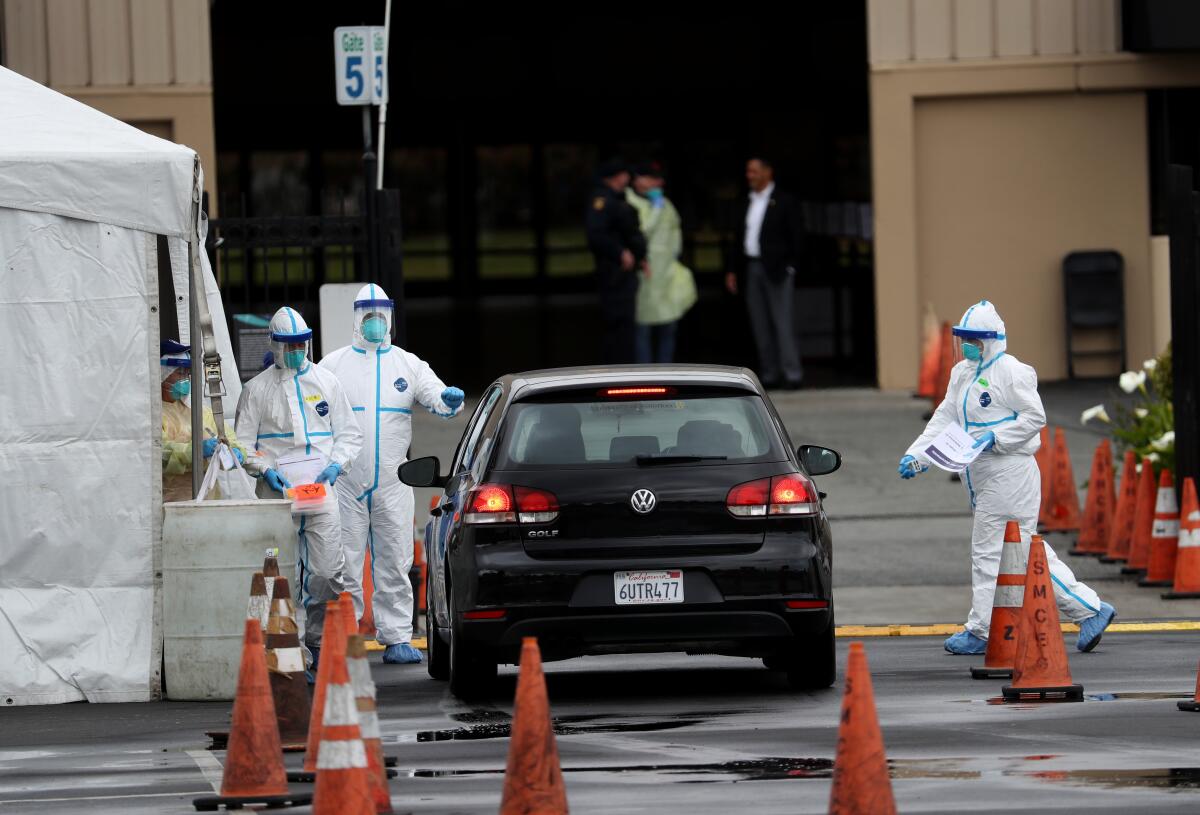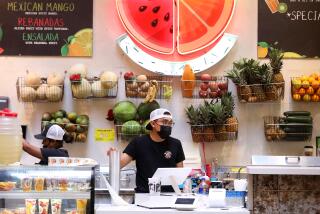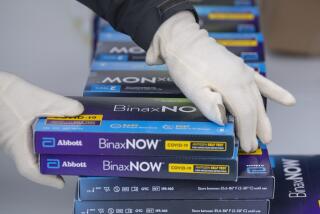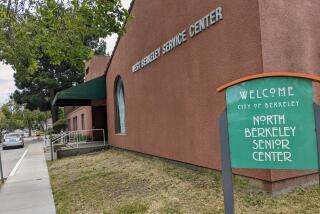Coronavirus testing lags in U.S., with only a fraction of suspected cases tested so far

- Share via
Federal and state officials on Monday said they had finally turned a corner on the coronavirus pandemic and promised a massive expansion of testing, but hopes remained dim in hospitals and clinics as patients still awaited results and overworked doctors sharply questioned the government’s latest pledge.
Some physicians in Los Angeles County said it is still nearly impossible to order a coronavirus test because the process is slowed by bureaucratic hurdles and shortages of key materials. “The testing spigot has definitely not opened up,” said one L.A. County emergency room doctor. She still faces tight restrictions on which patients qualify for testing and then has to wait for results for five days, she said.
Leigha Hodnet, 42, said she was still waiting for test results nearly one week after she and her partner were tested at a lab in Burbank. “We’re trying to self-quarantine, but it’s just really crazy,” said Hodnet, who lives in Echo Park and said her symptoms included a fever, cough and extreme fatigue. “One way to stop it is to make sure everyone can get tested and self-quarantine. But if they can’t, that’s how this becomes a pandemic.”
The ongoing problems come as the nation approaches a critical moment in its battle against the pandemic, with infections mounting, schools and businesses closing, and the economy at risk of tipping into a recession. If widespread testing doesn’t accelerate, health experts fear more extreme safety measures, such as mandatory home isolation and city lockdowns, may be necessary.
“I’ve said many times, and I’ll repeat it: The worst is, yes, ahead for us. It is how we respond to that challenge that’s going to determine what the ultimate endpoint is going to be,” said Dr. Anthony Fauci, director of the National Institute of Allergy and Infectious Diseases, part of the National Institutes of Health.
The lack of widespread testing early on in the U.S. made it nearly impossible to track the virus and ultimately forced the closure of schools and businesses in many cities nationwide in a desperate attempt to stop the spread of the contagion. Officials insist change is coming.
By the end of the week, more than 2,000 commercial labs across the nation will be performing coronavirus tests using high-speed machines that can process many samples at once, federal officials said Sunday. About 1.9 million tests would be available by the end of the week, officials said.
California will be running 8,000 tests a day in about a week, when the commercial lab company Quest opens up two more labs, said Gov. Gavin Newsom in a news conference Sunday. “We are increasing our capacity on an hourly basis, not just a daily basis,” Newsom said.
The acceleration comes as officials attempt to compensate for a cascade of federal missteps and delays that experts say left the United States far behind other countries in its tracking of the novel coronavirus. As of Monday, the U.S. had tested roughly 40,000 people for the virus, while South Korea, a country six times smaller, had tested more than 260,000.
“You cannot fight a fire blindfolded, and we cannot stop this pandemic if we do not know who is infected,” said World Health Organization director Tedros Adhanom Ghebreyesus on Monday. “We have a simple message for all countries: test, test, test.”
As of Sunday, 8,316 coronavirus tests had been conducted in California. And less than one-third of those were processed in the state’s 19 public health laboratories, which are suffering shortages of testing components and lack of machinery and staffing. The rest have been analyzed in commercial facilities and labs at universities and private hospitals, including Stanford and several University of California facilities.
The U.S. testing problems began early in the outbreak, when the Centers for Disease Control and Prevention distributed a faulty test to public health labs around the country. Once the issue was remedied, it took weeks to supply states with adequate test kits, as the number of suspected patients who required testing continued to climb. A shortage in basic testing chemicals, called reagents, slowed the process down further.
That issue persists for local officials who are struggling to contain the spread of the virus.
L.A. County public health chief Barbara Ferrer said that though the county’s testing capacity had “increased dramatically” in recent days, to a rate of about 300 samples per day, the county is still waiting for the federal government to supply more reagent. “If we don’t fix that reagent shortage very soon, then our capacity for testing at the public health labs will be dramatically reduced again,” Ferrer said at a news conference Monday.
About 1,100 people in total have been tested in the county, the public health department said.
The Bay Area is experiencing similar problems. One physician experienced the COVID-19 testing mess firsthand last week. Officials told him that his high fever, chills and cough did not qualify him for a COVID-19 test but that he could get tested for the flu, since he hadn’t had contact with anyone who had traveled to a country with an outbreak.
“The tests are so preciously few in availability that the only people who can get tested are the only people who meet very stringent criteria, and in my opinion that criteria are kind of ridiculous,” he said. “It’s a circular thing because how do you know if you’ve been having any contact with COVID-19 patients if hardly anyone is getting tested.”
In L.A. County, doctors said it seemed like the testing restrictions were intended to avoid overwhelming the commercial labs, Quest and LabCorp. “It’s very cautious and restrictive,” said one emergency room doctor in the county, who was not authorized to speak to the media. “We don’t know if it’s an issue of machines, manpower, reagents, or what. But it seems like Quest and LabCorp do not actually have the capacity for all these samples pouring in, and we don’t want to overwhelm them.”
Dr. Anthony Cardillo, chief executive of Mend, the urgent care clinic that treated Hodnet, the Echo Park woman, said the delay in receiving her test results stems from a backlog at Quest. The company, he said, was overloaded with people sending in tests to be run when the lab came online last week. Quest decided to freeze the samples and run them this week and next week, prioritizing people with more severe symptoms, Cardillo said.
He said that Quest reduced the backlog over the weekend, but Mend staff still tell patients it could take up to two weeks for their results to come back.
“There’s no way to predict that — there’s no hard answer,” he said. “It’s like trying to ask a pilot who’s circling in the fog, when they’re going to land — whenever the fog clears.”
Thus far, Quest has been running 1,200 tests daily at a single lab in San Juan Capistrano. Two additional labs will come online within the next week, together running up to 5,500 samples a day, Newsom said Sunday.
Quest cited even more ambitious estimates Monday. Officials said daily testing capacity could be as high as 10,000 by the end of the week, and planned to double that rate by April 1.
“We’re now in a new phase of testing,” said Adm. Brett P. Giroir, assistant secretary for health at the Department of Health and Human Services, at the Sunday White House briefing.
But the weeks-long testing debacle continues to affect Californians, including Renee Schwartz, who was sick for weeks with a fever and dry cough, the hallmarks of COVID-19.
After weeks of being unable to get tested, she visited UCLA last week to meet with an infectious disease doctor to be evaluated for testing. But she was denied again because her fever had broken, though she still had a nasty cough.
“Everything else got ruled out, it’s the only thing it can be,” said Schwartz, who lives in North Hills. “If somebody could tell me where to go, I’d go. I think it’s a total cluster you-know-what.”
Her symptoms are improving, but she says she still has only about 70% of her normal energy level. She had been holing up in her home, but has now stopped, hoping she is no longer contagious.
“I don’t know what else to do. It’s been 20 days,” Schwartz said.
Times staff writers Phil Willon and Colleen Shalby contributed to this report.
More to Read
Sign up for Essential California
The most important California stories and recommendations in your inbox every morning.
You may occasionally receive promotional content from the Los Angeles Times.












